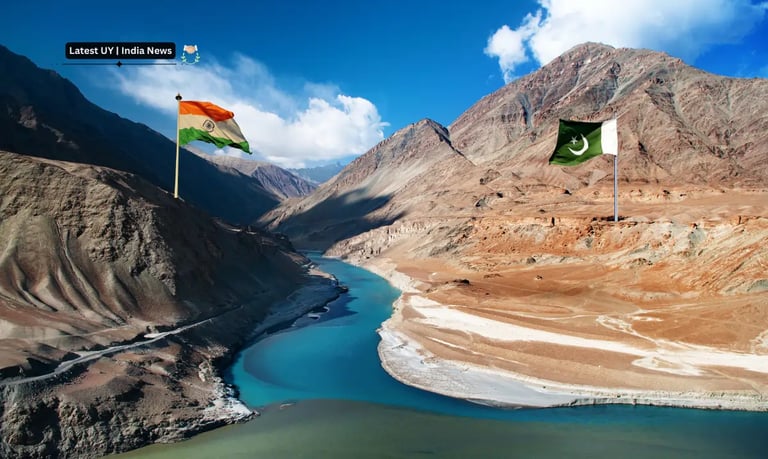The Pahalgam Attack
HINDU NATION


“Water has memory. And now, it will also have a voice.”
India’s "Brahmastra" Move: Suspending the Indus Water Treaty Amid Rising Tensions
In a bold and strategic decision, India has announced the suspension of its participation in the Indus Water Treaty (IWT) — a move that signals a dramatic shift in South Asian geopolitics. This action comes in the wake of the Pahalgam terror attack on April 22, 2025 , which left 26 Indian tourists dead and reignited tensions with Pakistan.
Let’s take a deep dive into what this means, why it matters, and how it could reshape the future of India-Pakistan relations.
The Pahalgam Attack: A Breaking Point
On April 22, 2025 , a coordinated terror attack struck near the popular tourist destination of Pahalgam in Jammu and Kashmir , killing 26 civilians . The Indian government has strongly implicated Pakistan , accusing Islamabad of once again supporting cross-border terrorism — an allegation Pakistan denies.
This tragic event marks one of the most significant escalations since the 2019 Pulwama attack , which claimed the lives of 40 Indian soldiers . In response, India has taken multiple strong actions:
Downgraded diplomatic ties
Expelled Pakistani nationals (reports suggest)
Suspended operations under the Indus Water Treaty
A New Strategic Reality: Reservoir Flushing Without Notice
In a move that caught many by surprise, India initiated reservoir flushing operations at two key hydroelectric projects in Kashmir — Salal and Baglihar — without informing Pakistan .
This is notable because such activities were previously governed by strict protocols under the IWT. It also marks the first time India has undertaken such maintenance independently , signaling a major departure from treaty obligations.
The Indus Water Treaty: A Skewed Agreement?
Signed in 1960 under the auspices of the World Bank , the Indus Waters Treaty was meant to resolve water-sharing disputes between India and Pakistan. However, over the decades, several flaws have come to light:
⚖️ Unequal Water Distribution
Despite controlling 40% of the Indus basin catchment area , India receives only 20% of the total water flow.
Conversely, Pakistan gets 80% of the river system’s waters.
🏗️ Pre-Partition Infrastructure Gap
At the time of partition, West Punjab (now in Pakistan) had a well-developed irrigation network of 140 canals , while India had just 12 .
💰 Financial Imbalance
India contributed to the Indus Basin Development Fund , helping Pakistan build its infrastructure — despite receiving less water.
🚧 Obstructionist Tactics
Pakistan has frequently objected to Indian water projects and delayed dispute resolution processes, undermining the treaty’s cooperative intent.
Why India Is Reassessing the Treaty Now
India’s decision to suspend the treaty isn’t impulsive — it reflects a broader reassessment driven by several key factors:
🔹 Persistent Cross-Border Terrorism
Continued support for militant groups operating in India has eroded trust in bilateral cooperation.
🔹 Climate Change and Resource Needs
With climate change impacting water availability , and rising energy demands , India needs more flexibility in managing its water resources.
🔹 Pakistan’s Breach of Protocol
India accuses Pakistan of violating the spirit of the treaty by:
Filing duplicate cases (both arbitration and neutral expert review) on the same issues.
Consistently blocking Indian projects through legal delays.
What Does This Mean Strategically?
India’s suspension of the IWT is being seen as a strategic “brahmastra” — a powerful weapon deployed in response to ongoing threats and inequities.
🌊 Control Over Water Flow Data
India may no longer be obligated to share advance information about water releases, potentially affecting flood forecasting and agricultural planning in Pakistan .
🛠️ Revival of Stalled Projects
With the treaty paused, India can now resume work on long-delayed hydroelectric and irrigation projects in J&K without prior consultation.
📈 Regional Benefits
Increased water usage will primarily benefit Jammu and Kashmir , aligning with India’s development goals in the Union Territory.
⚖️ Long-Term Leverage
Given Pakistan’s heavy reliance on the Indus River system, India’s move gives it significant geopolitical leverage in future negotiations.
Pakistan has already condemned the suspension, calling it an “act of war” , suggesting further friction ahead.
India’s Foreign Policy Evolution: From Restraint to Assertiveness
Over recent years, India has shifted from a diplomatic posture of restraint to one of assertive deterrence . This evolution is evident in:
Military responses like Balakot airstrikes (2019)
Economic and political isolation of Pakistan in multilateral forums
Strong international messaging around counter-terrorism
While India considers global reactions, its decisions are increasingly guided by national interests and security imperatives . The United States and other Western nations have expressed solidarity with India following the Pahalgam attack.
Conclusion: A Watershed Moment in South Asia
India’s suspension of the Indus Water Treaty is not just a technical adjustment — it is a strategic recalibration in response to persistent terrorism, historical imbalance, and evolving national needs.
This “brahmastra” move sends a clear message: India will no longer tolerate exploitation of goodwill or compromise on sovereignty and security .
As both nations brace for potential escalation, the world watches closely — because the future of water, peace, and power in South Asia is shifting .
